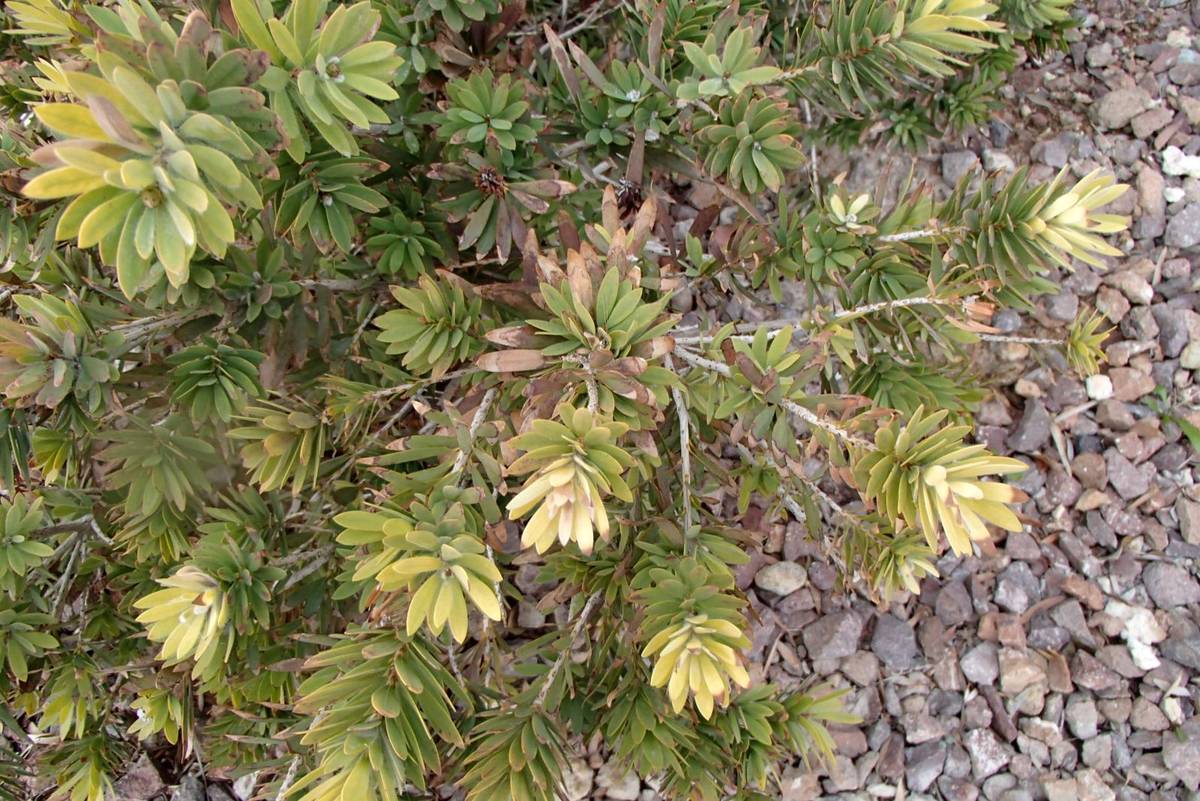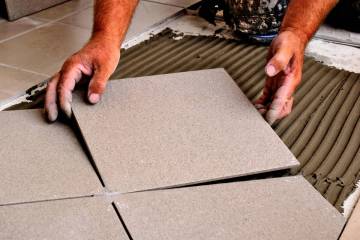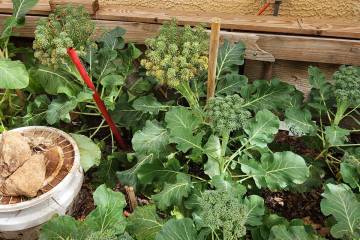Late-winter freezes can damage plants
We can expect freezes most anytime from mid-December to the end of February. According to the weather information from McCarran International Airport a couple of years ago, a freeze occurred in the valley in the middle of November and the weather never warmed up after that.
Just last spring, snow fell in the early morning hours in the downtown area and stuck to the ground around McCarran in late February. Freezing temperatures can occur here anytime during the fall, winter and spring months, not just during the dead of winter.
This winter, the valley hasn’t had any freezing temperatures at lower elevations. After March 15, the chance of having a freeze somewhere in the valley is five years every 100 years; pretty low but it’s still possible. Let’s not forget about chilling injury (damage occurring somewhere around 50 to 45 degrees Fahrenheit) in new growth and fruits of tropical plants like tomatoes.
What should we do about it? Eliminate fertilizers after July 1. Pushing new growth makes tender plants more sensitive to freezing temperatures. This will give you a couple of degrees of safety from freezing. Tender plants are fine with a fertilizer application just before new growth in spring and a second one in late summer when necessary.
Recognize there are microclimates, pockets of warmth and cold, in every landscape. If these don’t occur naturally, create them by capturing warmth during the winter months and preventing wind from blowing it away. Hardscape like fences and short walls help a lot in this regard and don’t use any water.
Be informed. Install a recording outside thermometer in the garden area and track when freezing temperatures occur. Accurate battery-operated maximum/minimum thermometers aren’t expensive and give hyper-local temperature information.
Secondly, install a weather app on your cellphone or computer such as AccuWeather and look at seven- to 14-day temperature and wind trends before planting.
Thirdly, use an accurate soil temperature thermometer (again, not expensive) and measure the temperatures of the soil before planting. Warm up soil by amending it a couple of weeks before planting.
Be aware of the temperature limitations of landscape plants before buying them and placing them in landscape microclimates. Some plants will not survive the winter unless it doesn’t freeze. Other plants are damaged at around 25 degrees.
In my opinion, trees and shrubs extremely important to your overall landscape should withstand 20-degree minimum temperatures. Consider plants that can’t expendable when cold temperatures occur.
Q: I have had horrible luck with my orange and lemon trees since I moved here from California. I’ve had numerous flowers, bees galore and a lot of fruit buds only for the fruit to fall off almost immediately. I grew up in east Los Angeles, and I don’t remember this many problems with my citrus and avocados there.
A: Yours is a common question I get about growing citrus here. The eastern Mojave Desert is a borderline citrus area. Sometimes they work out; sometimes not.
Please don’t compare growing plants in Las Vegas versus Los Angeles. The biggest difference between these two spots is our winter freezing temperatures. These winter temperatures are brutal compared to Los Angeles.
Orange and Riverside counties in Southern California have been famous for sweet orange production since the 1800s. This was primarily due to the Washington navel oranges, which struggle in the Las Vegas Valley because of winter cold.
Cold temperatures during the winter decimate many of our citrus plants. It’s just too cold to grow most citrus here unless they are protected.
The second problem can be our late spring freezes. If citrus survives the winter temperatures, the tender spring flowers may not. A double whammy. Any freezing temperatures while the plants are blooming can eliminate 100 percent of the fruit from small trees for that year.
The third problem is wind. I contend that wind decreases fruit production. We know this is true with agricultural crops, but I believe it’s also true when growing fruit trees.
Fruit trees growing in orchards protect each other from the wind. Fruit trees grown in residential landscapes are oftentimes out in the open and more prone to wind damage.
Many fruit trees perform better when protected from the wind. If citrus is grown where it is protected from the wind, it produces a better crop of fruit.
Q: Which types of citrus do you recommend for Las Vegas?
A: Growing citrus is like realty; it’s all about location, location, location. This is not citrus country.
It’s much easier to grow citrus in some parts of the valley than others. So, you must find or create a place in your landscape where it will be a success. It’s all about which citrus you want to grow and finding the right location for it.
Warm locations protected from cold winter winds are the best locations for any type of citrus. The lowest temperature and how long it stays there determines their fate. In fact, protecting any type of fruit tree from wind is important any time of the year whatever type of fruit tree you are considering.
Types of citrus range from tropical to subtropical climates. The most cold-tolerant types of citrus are the kumquats, Meyer lemon (not so for true lemons like Ponderosa or Lisbon), grapefruit and Satsuma or clementine mandarin (tangerine-type) oranges.
Rootstock type also plays a role, so the most cold-hardy rootstock is the best. When buying locally, that will be selected for you but not necessarily online.
True lemons, limes and sweet oranges like navel and blood orange are more tropical in nature, more likely to be damaged during freezing temperatures and consequently need more protection from winter cold.
Pay attention to when the citrus you want produces flowers. Late spring freezing weather kills citrus flowers regardless of the tree’s cold tolerance for winter temperature lows. As these trees get older and larger, they are less likely to lose their entire crop during a spring freeze.
Q: We just planted a night-blooming Cereus peruvianus cactus that is 3 feet tall. The information says it can handle direct sunlight, which is most of the day for us. Do I need to cover or wrap this plant for the winter?
A: This night-blooming, tall and upright columnar cactus should not be confused with the native cactuses found in the Mojave Desert. Our native Mojave Desert cactuses can handle anything you throw at them except watering too often.
This columnar cactus is a little more delicate. It should be planted in full sun but may have problems if it’s neglected.
Your cereus cactus should handle temperatures as low as 20 degrees during the wintertime if it is a true Peruvian apple cactus. There are some similar cactuses sold that resemble Peruvian apple cactus but are not as tolerant of cold temperatures.
It should not need any winter protection. However, I would be careful putting it on drip irrigation, and make sure the soil is amended and well-drained at the time of planting. Watering too often and poor water drainage around its roots will kill it.
This cactus is not used very much in residential landscapes. That’s unfortunate because it can handle unusually low temperatures.
Q: I purchased a small white sapote fruit tree and planted it on the north side of my home in Las Vegas where it can get diffuse sunlight. Since planting this past fall, it has grown a new flush and looks much healthier. What do I need to know to make it flourish here?
A: Good job planting it on the north side of the home where this Mexican apple can get a break from our intense desert sunlight. Please realize this is a subtropical tree that grows natively in southern Mexico and Costa Rica, not the Mojave Desert.
Outside of southern Mexico, it grows best in dry but warm climates well-suited for sweet oranges such as Southern California. There is a history of its growth by hobbyists, like yourself, there. It will probably struggle in any desert climate because of the heat and dry winds.
When it struggles, you will see the leaves browning along the edges during the summer months because of our extremely low humidity, not because of intense sunlight. You might not see this until it gets older. Make sure the soil surrounding its roots has been amended with compost and covered with a 4-inch layer of wood chips. That will help.
During the winter months, it will struggle and probably die back if there are freezing temperatures and wind while young. As it gets older, low winter temperatures are less damaging provided they stay above 25 degrees.
The two problems you will face are temperature-related: winter freezing and high temperatures during the summer months. Fertilize these trees once in late spring with your favorite fertilizer.
Bob Morris is a horticulture expert and professor emeritus of the University of Nevada, Las Vegas. Visit his blog at xtremehorticulture.blogspot.com. Send questions to Extremehort@aol.com.























